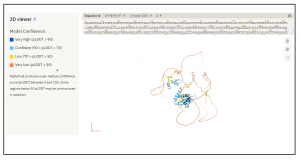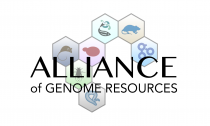Difference between revisions of "SGD Newsletter, Fall 2021"
(→AlphaFold Predicts 3D Protein Structure) |
|||
| Line 15: | Line 15: | ||
https://alphafold.ebi.ac.uk/about | https://alphafold.ebi.ac.uk/about | ||
| − | [[File:AlphaFold graphic.png|thumb|left|upright=. | + | [[File:AlphaFold graphic.png|thumb|left|upright=.99]] |
*With a cutting-edge AI system, EMBL’s European Bioinformatics Institute (EMBL-EBI) offers a new, highly accurate tool for predicting protein structure with speed and clarity. | *With a cutting-edge AI system, EMBL’s European Bioinformatics Institute (EMBL-EBI) offers a new, highly accurate tool for predicting protein structure with speed and clarity. | ||
| Line 24: | Line 24: | ||
*Whether or not a family is identified, the comparison will yield clues to protein function to help design the next experiments. | *Whether or not a family is identified, the comparison will yield clues to protein function to help design the next experiments. | ||
| − | |||
| − | |||
| − | |||
==YeastMine Updates== | ==YeastMine Updates== | ||
Revision as of 07:34, 3 November 2021
About this newsletter:
This is the Fall 2021 issue of the SGD newsletter. The goal of this newsletter is to inform our users about new features in SGD and to foster communication within the yeast community. You can view this newsletter as well as previous newsletters on our Community Wiki.
Contents
Nomenclature Updates
- YNC for ncRNA
- YSC for NISS
- legacy gene names
AlphaFold Predicts 3D Protein Structure
https://alphafold.ebi.ac.uk/about
- With a cutting-edge AI system, EMBL’s European Bioinformatics Institute (EMBL-EBI) offers a new, highly accurate tool for predicting protein structure with speed and clarity.
- Given a peptide sequence for an uncharacterized protein, AlphaFold will model predicted domains and provide relative confidence levels for each portion of the prediction.
- The predicted domains can then be compared to known protein structures (using a tool such as PDBeFold, https://www.ebi.ac.uk/msd-srv/ssm/) to seek matches to characterized protein families.
- Whether or not a family is identified, the comparison will yield clues to protein function to help design the next experiments.
YeastMine Updates
SGD has updated YeastMine with ...
Alliance of Genome Resources at [Version 4.1]
The Alliance of Genome Resources, a collaborative effort from SGD and other model organism databases (MOD), released version 4.1 in August. Notable improvements and new features include:
- Added Human and model organism high throughput (HTP) variant data.
- Human variants are imported from Ensembl.
- Model organism HTP variants are submitted by Alliance members (FlyBase, RGD, SGD, Wormbase) or imported from EVA (mouse and zebrafish).
- Added HTP variants to the Alleles and Variants table on gene pages (e.g. rat Lepr Gene page) and to the table on the Alleles and Variants Details page (e.g. rat Lepr Alleles and Variants Details.
- Created a report page for Human and model organism HTP variants (e.g. human variant rs1041354454).
- Expanded Allele Category in search to “Allele/Variant” and added a search for HTP variants.
- HTP variants are currently only displayed for variants within a gene. Intergenic variants will be available in a future release.
- On Gene Pages, a new Pathways widget displays via tabs:
- Reactome models of pathways for human gene products as well as inferred pathways for model organism genes based on orthology to human genes.
- Reactome reactions for gene products (e.g. human TP53 Gene page)
- Gene Ontology Causal Activity Models (GO-CAMs). These provide a framework to represent a biological system by linking together multiple GO annotations. PMID:31548717 (e.g. worm nsy-1 Gene page).
Experimental conditions are include for Disease and Phenotype data in tables on Gene, Allele, and Disease pages (e.g. zebrafish scn1lab Gene page).
- AllianceMine added Orthologs, and Allele and Variants (low throughput) data types to this release. You can now query for these data types via pre-made template queries.
- The Alliance Community Forum is released. The Forum permits discussions across six model organism communities—flies, mice, yeast, rats, worms, and zebrafish. More details will follow.
Gene Ontology Consortium Fall Meeting
Held virtually October 12 to October 14, with participants from XX countries. Featuring presentations on:
- Internal updates from the Gene Ontology Consortium
- Gene Alliance Pathway Viewer
- Metrics analysis
- LitSuggest
- ECO, Evidence and Conclusions Ontology
- Reactome
- RNA Central
- PAINT
- Harmonizing Regulates closure over the various GOC products
- Complex Portal New annotation
- JaponicusDB
- ChEBI
- UniProt: Plan for pathway curation
- Subsets analysis
Upcoming Publication in Genetics Issue XX
- GENOME VERSION R64.3.1
- ALLELES
- HOMOLOGY AND THE ALLIANCE OF GENOME RESOURCES
- OTHER UPDATES
Happy Holidays from SGD!
(NEEDS UPDATE) We would like to take this opportunity to recognize that 2020 has brought many changes and challenges for everyone. Our thoughts go out to all those who have been impacted by the unprecedented events of this year.
We wish you and your family, friends, and lab mates the best during the upcoming holidays. Stanford University will be closed for three weeks (???) starting on December 20 (???) and will reopen on January 4th (???) , 2022. Although SGD staff members will be taking time off, the website will be up and running throughout the winter break, and we will resume responding to user requests and questions in the new year.


